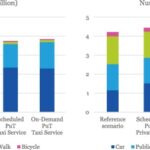銀河系外核のコヒーレントなイメージの形成に、最新機器が貢献 Advanced instruments aid in development of coherent picture of extragalactic nucleus
2022-11-14 カリフォルニア大学校アーバイン校(UCI)
NGC 7469は、超巨大ブラックホールと星形成領域のリングを持つ活動的な中心部を持つセイファート銀河で、全銀河の約10パーセントを占めるこの系の詳しいダイナミクスを何十年にもわたって研究してきましたが、中心部に多く存在する塵がそれを阻んできた。JWSTは、研究者たちに、ダストのベールの向こうにあるものにアクセスする機会を与えてくれた。
JWSTの6.5m鏡と中間赤外線観測装置などの高度な観測装置を用いて、研究者たちは、星間物質(銀河の星系の間に存在するガス、塵、放射線)の状態について天文学者に情報を与えるいくつかの重要なイオン化ガスと分子ガスの輝線を描き出し、スターバーストリング内の星形成領域を正確に特定することに成功した。また、電離したガスが高速で流れ出し、観測者に向かってくる「ブルーシフト」を検出した。
JWSTの中間赤外線観測装置で新たに実現した中間赤外線積分フィールド分光観測により、塵の背後にあるものだけでなく、これまでこの波長では見えなかった非常に小さなスケールでの動きも見ることができるようになった。
<関連情報>
- https://news.uci.edu/2022/11/14/uci-led-astronomers-capitalize-on-early-access-to-james-webb-space-telescope-data/
- https://iopscience.iop.org/article/10.3847/2041-8213/ac961c/meta
GOALS-JWST:NGC 7469 の円周核ガスダイナミクスの中間赤外線による解像 GOALS-JWST: Resolving the Circumnuclear Gas Dynamics in NGC 7469 in the Mid-infrared
Vivian U, Thomas Lai, Marina Bianchin, Raymond P. Remigio, Lee Armus, Kirsten L. Larson, Tanio Díaz-Santos, Aaron Evans, Sabrina Stierwalt, David R. Law, Matthew A. Malkan, Sean Linden, Yiqing Song, Paul P. van der Werf, Tianmu Gao, George C. Privon, Anne M. Medling, Loreto Barcos-Muñoz, Christopher C. Hayward, Hanae Inami, Jeff Rich, Susanne Aalto, Philip Appleton, Thomas Bohn, Torsten Böker, Michael J. I. Brown, Vassilis Charmandaris, Luke Finnerty, Justin Howell, Kazushi Iwasawa, Francisca Kemper, Jason Marshall, Joseph M. Mazzarella, Jed McKinney, Francisco Muller-Sanchez, Eric J. Murphy, David Sanders, and Jason Surace
The Astrophysical Journal Letters Published: 2022 November 14
DOI:10.3847/2041-8213/ac961c

Abstract
The nearby, luminous infrared galaxy NGC 7469 hosts a Seyfert nucleus with a circumnuclear star-forming ring and is thus the ideal local laboratory for investigating the starburst–AGN (active galactic nucleus) connection in detail. We present integral-field observations of the central 1.3 kpc region in NGC 7469 obtained with the JWST Mid-InfraRed Instrument. Molecular and ionized gas distributions and kinematics at a resolution of ∼100 pc over the 4.9–7.6 μm region are examined to study the gas dynamics influenced by the central AGN. The low-ionization [Fe ii] λ5.34 μm and [Ar ii] λ6.99 μm lines are bright on the nucleus and in the starburst ring, as opposed to H2 S(5) λ6.91 μm, which is strongly peaked at the center and surrounding ISM. The high-ionization [Mg v] line is resolved and shows a broad, blueshifted component associated with the outflow. It has a nearly face-on geometry that is strongly peaked on the nucleus, where it reaches a maximum velocity of −650 km s−1, and extends about 400 pc to the east. Regions of enhanced velocity dispersion in H2 and [Fe ii] ∼ 180 pc from the AGN that also show high L(H2)/L(PAH) and L([Fe ii])/L(Pfα) ratios to the W and N of the nucleus pinpoint regions where the ionized outflow is depositing energy, via shocks, into the dense interstellar medium between the nucleus and the starburst ring. These resolved mid-infrared observations of the nuclear gas dynamics demonstrate the power of JWST and its high-sensitivity integral-field spectroscopic capability to resolve feedback processes around supermassive black holes in the dusty cores of nearby luminous infrared galaxies.



